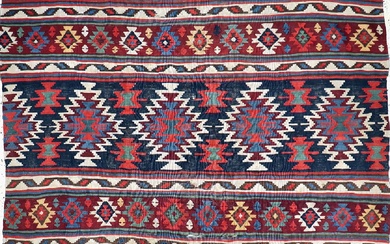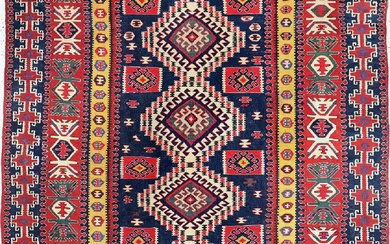Antique Shirwan 223 x 129 cm
Origin :Â Caucasus
Size:Â 223x129 cm (Approximately 87.8 X 50.8 inch)
Age:Â 2nd quarter of 20th century
Knots: 6 x 6 = 36 knots per sq cm
Condition: Excellent, collectable, decorative example.
Description of Design and History:
Shirvan rugs “ The historic Khanate or administrative district of Shirvan produced many highly decorative antique rugs that have a formality and stylistic complexity that is found in few rugs from the Caucasus. The depth of colors, the complexity of the composition and the phenomenal patterns featured in antique Shirvan rugs set them apart from those produced in other regions of the Caucasus. Shirvan, which is part of modern-day Azerbaijan, was populated by Azeri Turks and some Armenians, who were expert dyers and weavers. The format is generally long and narrow, which would have been preferred by consumers in the Caucasus. This format lends itself well to multi-medallion compositions.
Grand symbol-filled medallions with polychrome accents are featured prominently as are all-over Afshan patterns, which are a sort of angular arabesque filled with dramatic harshang palmettes. Stunning allover patterns featuring symbolic devices and a latticework of angular floral sprigs are also used. Fine prayer rugs with angular mihrabs are made in the area as well. Rugs from the Shirvan region include those produced in Marasali, Bakuand other local cities and villages with the largest carpets coming from Baku. Regardless of the format or the patterns featured, antique Shirvan carpets are full of strong colors, powerful symbols and subtle details that add to their stylistic richness.
Shirvan rugs are often the most sought after antique rugs from the Caucasus. Shirvan rugs were made not far from those of Kuba, which are closely related in terms of design and coloration. But Shirvans tend to be distinguished by a larger, more supple weave. They also leaned more to medallion designs, while Kubas relied more on allover patterns. Still, Shirvan rugs and Kubas constitute something of a contrast to the bolder more graphic quality of South Caucasian rugs like Kazaks and Karabaghs. Instead they are more finely detailed, relying on precise articulations of form as well as the effects of rich color.
Condition Report: The absence of a condition report does not imply that the lot is in perfect condition. Please carefully read our terms of sale, shipping pick up & payment information. We are happy and willing to answer questions about any of our lots as well as to send additional images. It is the responsibility of the bidder to pose any questions BEFORE bidding. Please email us for a shipping quote if needed. All sales are final.
View it on
Estimate
Time, Location
Auction House
Origin :Â Caucasus
Size:Â 223x129 cm (Approximately 87.8 X 50.8 inch)
Age:Â 2nd quarter of 20th century
Knots: 6 x 6 = 36 knots per sq cm
Condition: Excellent, collectable, decorative example.
Description of Design and History:
Shirvan rugs “ The historic Khanate or administrative district of Shirvan produced many highly decorative antique rugs that have a formality and stylistic complexity that is found in few rugs from the Caucasus. The depth of colors, the complexity of the composition and the phenomenal patterns featured in antique Shirvan rugs set them apart from those produced in other regions of the Caucasus. Shirvan, which is part of modern-day Azerbaijan, was populated by Azeri Turks and some Armenians, who were expert dyers and weavers. The format is generally long and narrow, which would have been preferred by consumers in the Caucasus. This format lends itself well to multi-medallion compositions.
Grand symbol-filled medallions with polychrome accents are featured prominently as are all-over Afshan patterns, which are a sort of angular arabesque filled with dramatic harshang palmettes. Stunning allover patterns featuring symbolic devices and a latticework of angular floral sprigs are also used. Fine prayer rugs with angular mihrabs are made in the area as well. Rugs from the Shirvan region include those produced in Marasali, Bakuand other local cities and villages with the largest carpets coming from Baku. Regardless of the format or the patterns featured, antique Shirvan carpets are full of strong colors, powerful symbols and subtle details that add to their stylistic richness.
Shirvan rugs are often the most sought after antique rugs from the Caucasus. Shirvan rugs were made not far from those of Kuba, which are closely related in terms of design and coloration. But Shirvans tend to be distinguished by a larger, more supple weave. They also leaned more to medallion designs, while Kubas relied more on allover patterns. Still, Shirvan rugs and Kubas constitute something of a contrast to the bolder more graphic quality of South Caucasian rugs like Kazaks and Karabaghs. Instead they are more finely detailed, relying on precise articulations of form as well as the effects of rich color.
Condition Report: The absence of a condition report does not imply that the lot is in perfect condition. Please carefully read our terms of sale, shipping pick up & payment information. We are happy and willing to answer questions about any of our lots as well as to send additional images. It is the responsibility of the bidder to pose any questions BEFORE bidding. Please email us for a shipping quote if needed. All sales are final.






